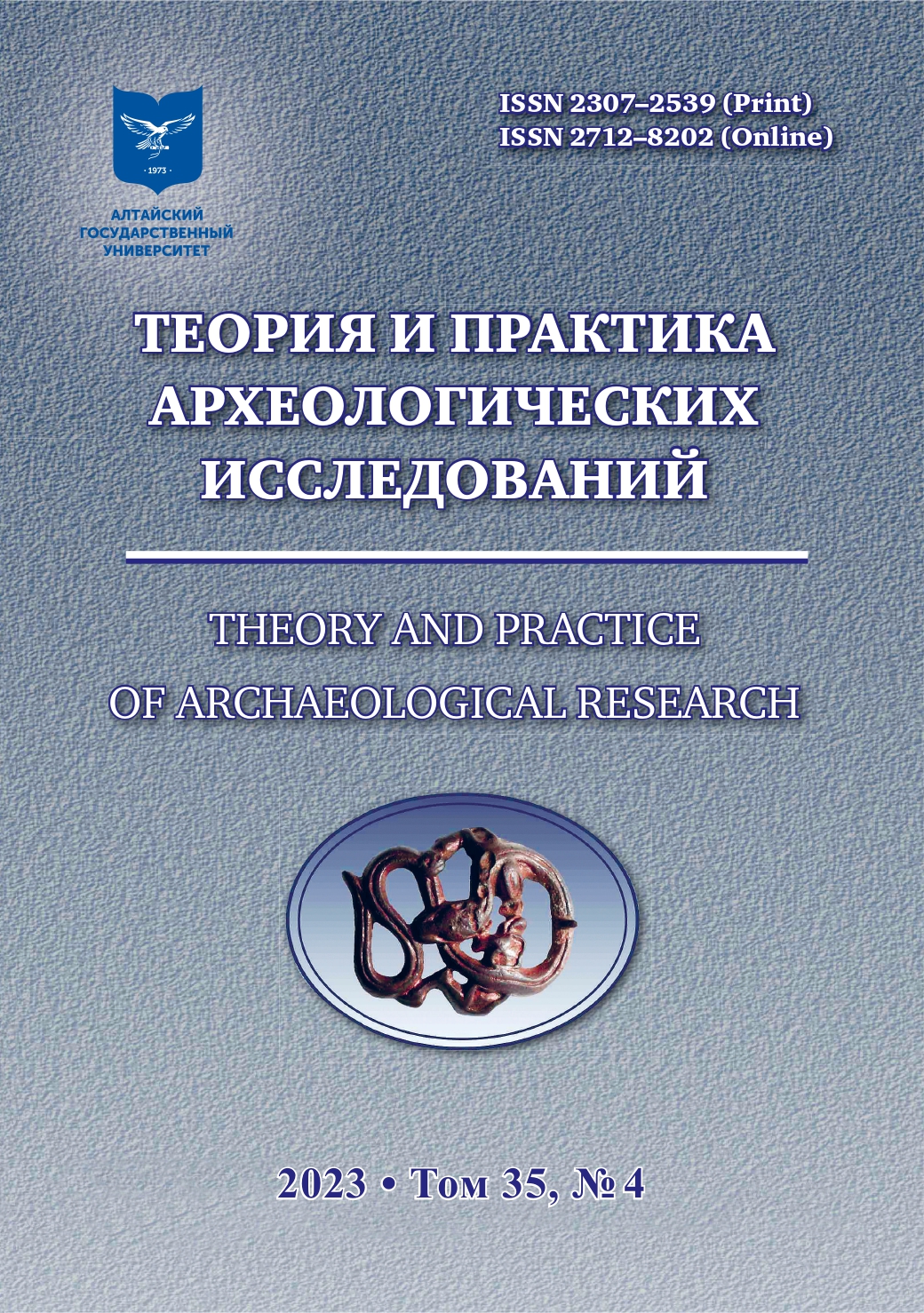НЕКОТОРЫЕ ПРОБЛЕМЫ ИЗУЧЕНИЯ ЛУКОВ В ОТЕЧЕСТВЕННОМ ОРУЖИЕВЕДЕНИИ
Аннотация
Статья посвящена анализу проблем терминологии и систематизации изучения луков в отечественной науке. Тематика разрабатывалась начиная с конца XIX в., дальнейшее развитие получила в результате становления оружиеведческого направления в середине XX в. Основной интерес специалистов до настоящего времени сконцентрирован на изучении луков народов древности, эволюции их конструирования и видоизменения, что обусловило специфику источниковой базы и применяемых методов: основные выводы делались на основе классификации отдельных деталей, а не изучения целых конструкций. Это стало причиной появления большого количества разнородных противоречивых реконструкций, а также создало ряд проблем методологического характера. В работах разных специалистов применялась разная, противоречащая друг другу терминология, которая могла не раскрываться в ходе исследования. Не было достигнуто единства в понимании отдельных элементов и функциональных зон, а также их соотношения с конкретными деталями. Было создано множество схем первичной систематизации материала, в большинстве случаев не включенных в основную классификационную иерархию. Кроме того, при описании материала могли опускаться вопросы применяемых материалов. Все это не могло повлиять на результаты проведенных исследований, однако значительно осложняет понимание опубликованного материала и ограничивает дальнейшие исследования. На основе анализа проблематики предлагаются решения, основанные на комплексном изучении луков населения Байкальского региона XII–XX вв., базирующемся на привлечении как археологического, так и этнографического материала. В основе авторской системы первичной систематизации отражены крупнейшие этапы развития конструкции луков, представляющие модифицирование посредством комбинирования материалов и создания концевых рычагов. Обосновано выделение нового функционального участка — переходной зоны. Вариант решения классификационной проблемы представляется последовательным иерархическим разделением: тип — набор накладок, вариант — их материал и особенности оформления. Указаны важнейшие моменты изучения целых конструкций, не рассматривавшиеся ранее специалистами, но имеющие принципиальное значение для понимания предметов: метрические и морфологические показатели, общая геометрия.
Скачивания
Литература
Adler B.F. Bows and Arrows of North Asia. Russkij antropologicheskij zhurnal = Russian Anthropological Journal. 1904;3,4:178–194. (In Russ.)
Akmatov K.T. Bows and Naluchi in the Population of the Tien Shan in the Mongolian Time. Vestnik Novosibirskogo gosudarstvennogo universiteta = Bulletin of Novosibirsk State University. Series: History, Philology. 2016;15(5):166–173. (In Russ.)
Anuchin D.N. Bows and Arrows. Archaeological and Ethnographic Sketch. With 73 Drawings in the Text. Reprint from Tr. V Tiflis Archaeological Congress. Moscow : Tip. A.I. Mamontova i Ko, 1887. 75 p. (In Russ.)
Artemev A.R. Bow of Prince Gantimur. Vestnik Dalnevostochnogo otdeleniya AN SSSR = Bulletin of the Far Eastern Branch of the USSR Academy of Sciences. 1990;5:155–159. (In Russ.)
Artemev A.R., Gajdukov P.G. Bow 13th Century from Novgorod. Rossijskaya arheologiya = Russian Archaeology. 1992;3:218–220. (In Russ.)
Atknin V.D., Glinskij E.A. Equipment of a Korean Archer. In: Korean and Mongolian Collections in the MAE Collections: Collection of the Museum of Anthropology and Ethnography. Vol. 41. Leningrad, 1987. Pp. 79–88. (In Russ.)
Bobrov L.A., Khudyakov Ju. S. Armament and Tactics of the Nomads of Central Asia and Southern Siberia during the Late Medieval and Early Modern Ages (15th — First Half of the 18th Century A.D.). Saint Petersburg : Filologicheskij fakultet SPbGU, 2008. 776 p. (In Russ.)
Gavrilova A.A. Kudyrge Burial Ground as a Source on the History of Altai Tribes. Moscow; Leningrad : Nauka, 1965. 145 p. (In Russ.)
Gorbunov V.V. Military Aff airs of the Population of Altai in the 3rd–14th Centuries. Part II: Offensive Weapons (weapons). Barnaul : Izd-vo Alt. un-ta, 2006. 232 p. (In Russ.)
Gorelik M.V. Weapons of the Ancient East (4th millennium — 4th century BC). Saint Petersburg: Atlant, 2003. 336 p. (In Russ.)
Darzha V.K. Traditional Tuvan Men’s Activities. Kyzyl : Tuvinskoe knizhnoe izd-vo, 2008.592 p. (In Russ.)
Ermolov L.V. Complex Mongolian Bow. In: Korean and Mongolian Collections in the MAE
Collections: Collection of the Museum of Anthropology and Ethnography. Vol. 41. Leningrad: Nauka, 1987. Pp. 149–155. (In Russ.)
Zhambalova S.G. Traditional Hunting of the Buryats. Novosibirsk : Nauka, 1991. 175 p.(In Russ.)
Izmajlov I.L. On the Reconstruction of the “Bulgarian” Type Bow from the Middle Volga and Kama Regions. In: Historical and Archaeological Study of the Volga Region. Joshkar-Ola: Marijskij gos. un-t, 1994. Pp. 39–44. (In Russ.)
Izmajlov I.L. On the History of the Composite Bow of the Population of the Middle Volga and Lower Kama Region of the Late 8th–10th Centuries. In: Cultures of the Eurasian Steppes of the Second Half of the 1st Millennium AD. (chronology issues). Samara : Samarskij oblastnoj istoriko-kraevedcheskij muzej im. P.V. Alabina, 1998. Pp. 242–259. (In Russ.)
Kruglov E.V. Complex Bows of Eastern Europe in the Early Middle Ages. In: The European Steppes in the Middle Ages. Vol. 4: Кhazarian times. Donetsk : Doneckij nacional’nyj universitet, 2005. Pp. 73–142. (In Russ.)
Kyzlasov I.L. 11th Century Bow from a Grotto in the Rock of Uzun-Khaya In: Questions of History of Siberia. Vol. 9. Omsk : Izd-vo OmGPU, 2014. Pp. 150–171. (In Russ.)
Litvinskij B.A. Complex Bow in Ancient Central Asia (to the problem of the evolution of onions in the East). Sovetskaya Arheologiya = Soviet Archaeology. 1966;4:51–69. (In Russ.)
Medvedev A.F. From the History of the Compound Bow. Tribes of the forest and forest-steppe zone of Eurasia in the 1st millennium BC. — 1st millennium AD. Moscow : Nauka,1964 Pp. 3–7. (KSIA. Vol. 102). (In Russ.)
Medvedev A.F. Hand-held Throwing Weapons (bow and arrows, crossbow) 8th–14th centuries.Moscow : Nauka, 1966. 128 p. (In Russ.)
Milovanov E.A., Ierusalimskaya A.A. Bow from Moshchevaya Balka. In: Communications of the State Hermitage. Vol. 41. Leningrad : Avrora, 1976. Pp. 40–43. (In Russ.)
Nechiporenko V.N., Pankin S.V., Skobelev S.G. Late Bows of the Middle Yenisei. In: Military Affairs of the Peoples of Siberia and Central Asia. Novosibirsk : Novosib. gos. un-t., 2004. Pp. 129–164. (In Russ.)
Okladnikov A.P. On the question of the Origin and Place of the Bow in the History of Culture. In: Brief Notes on the Reports and Field Research of the Institute of the History of Material
Culture. Vol. 5. Moscow ; Leningrad : Izd-vo AN SSSR. 1940. Pp.17–22. (In Russ.)
Okladnikov A.P. Neolithic and Bronze Age of the Baikal Region. Historical and Archaeological Research. Parts 1, 2. In: Materials on the Research of the History of the USSR. No 18. Moscow ; Leningrad : Izd-vo AN SSSR, 1950. 412 p. (In Russ.)
Savinov D.G. New Materials on the History of the Compound Bow and Some Questions of Its Evolution in Southern Siberia. In: Military Affairs of the Ancient Tribes of Siberia and Central Asia. Novosibirsk : Nauka, 1981. Pp. 146–162. (In Russ.)
Simchenko Yu.B. The Culture of Deer hunters in Northern Eurasia. Moscow : Nauka, 1976. 312 p. (In Russ.)
Solov’ev A.I. Weapons and Armor. Siberian Weapons: from the Stone Age to the Middle Ages. Novosibirsk : Infolio-press, 2003. 224 p. (In Russ.)
Tikhonov N.A., Khafi zova E.N. Complex Bow from the Nizhne-Arkhyz Settlement In: Military Archeology: Collection of Materials of the Problem Council “Military Archaeology” at the State Historical Museum. Vol. 3. [Online source]. Tula : Kulikovo pole, 2014. Pp. 6–14. URL: https://www.kitabhona.org.ua/libwar_bow/tihonow.html. (In Russ.)
Khazanov A.M. Compound Bows of the Eurasian Steppes and Iran in the Scythian-Sarmatian Era. In: Material Culture of the Peoples of Central Asia and Kazakhstan. Moscow : Nauka, 1966. Pp. 29–44. (In Russ.)
Khazanov A.M. Essays on the Military Affairs of the Sarmatians. Moscow : Nauka, 1971. 172 p. (In Russ.)
Kharitonov R.M. Retrospection in Weapons Science on the Example of the Buryat Traditional Bow. In: Proceedings of the International Archaeological Conference of Young Researchers. Novosibirsk : Izd-vo IAET SO RAN, 2022. Pp. 208–219. (In Russ.)
Khudyakov Yu.S. Basic Concepts of Weapon Science. In: New in the Archaeology of Siberia and the Far East. Novosibirsk : Nauka, 1979. Pp. 184–193. (In Russ.)
Khudyakov Yu.S. Armament of the Yenisei Kyrgyz 6th–12th Centuries. Novosibirsk : Nauka, 1980. 176 p. (In Russ.)
Khudyakov Yu.S. Armament of Medieval Nomads of Southern Siberia and Central Asia. Novosibirsk : Nauka, 1986. 270 p. (In Russ.)
Chernenko E.V. Scythian Archers. Kiev : Naukova dumka, 1981. 168 p.
Balfour H. On the Structure and Affinities of the Composite Bow. Th e Journal of the Antropological Institute of Great Britain and Ireland. 1890;XIX:Pp. 220–250.
Catalogue of the Anthropological Collection Lent by Colonel Lane Fox for Exhibition in the Bethnal Green Branch of the South Kensington Museum. Parts I. and II. London : G.E. Eyre and W. Spottiswoode, 1874. 184 p.
Dekker P. The Manchu Bow [Online source]: In: Fe Doro — Manchu archery. 2012. URL:http://www.manchuarchery.org/bows.
Karpowicz A. Osmanlı Türk Yayları: İmali ve Tasarım [Ottoman Turkish Bows: Manufacturing and Design]. İstanbul : Okçular Vakfı, 2018. 248 p. (In Turk.)
Luschan V. Zusammengesetzte und verstärkte Bögen. Zeitschrift für Ethnologie. [Composite and Reinforced Arches. Journal of Ethnology] 1899;XXXI:221–239. (In Ger.)
Murdoch J. A Study of the Eskimo Bows in the U. S. National Museum. In: Annual Report of the Board of Regents of the Smitshonian Institution. 1884. Pp. 307–316.
Copyright (c) 2023 Р.М. Харитонов

Это произведение доступно по лицензии Creative Commons «Attribution» («Атрибуция») 4.0 Всемирная.
Авторы, публикующиеся в данном журнале, соглашаются со следующими условиями:
a. Авторы сохраняют за собой права на авторство своей работы и предоставляют журналу право первой публикации этой работы с правом после публикации распространять работу на условиях лицензии Creative Commons Attribution License, которая позволяет другим лицам свободно распространять опубликованную работу с обязательной ссылокой на авторов оригинальной работы и оригинальную публикацию в этом журнале.
b. Авторы сохраняют право заключать отдельные договора на неэксклюзивное распространение работы в том виде, в котором она была опубликована этим журналом (например, размещать работу в электронном архиве учреждения или публиковать в составе монографии), с условием сохраниения ссылки на оригинальную публикацию в этом журнале. с. Политика журнала разрешает и поощряет размещение авторами в сети Интернет (например в институтском хранилище или на персональном сайте) рукописи работы как до ее подачи в редакцию, так и во время ее редакционной обработки, так как это способствует продуктивной научной дискуссии и положительно сказывается на оперативности и динамике цитирования статьи







2.jpg)






